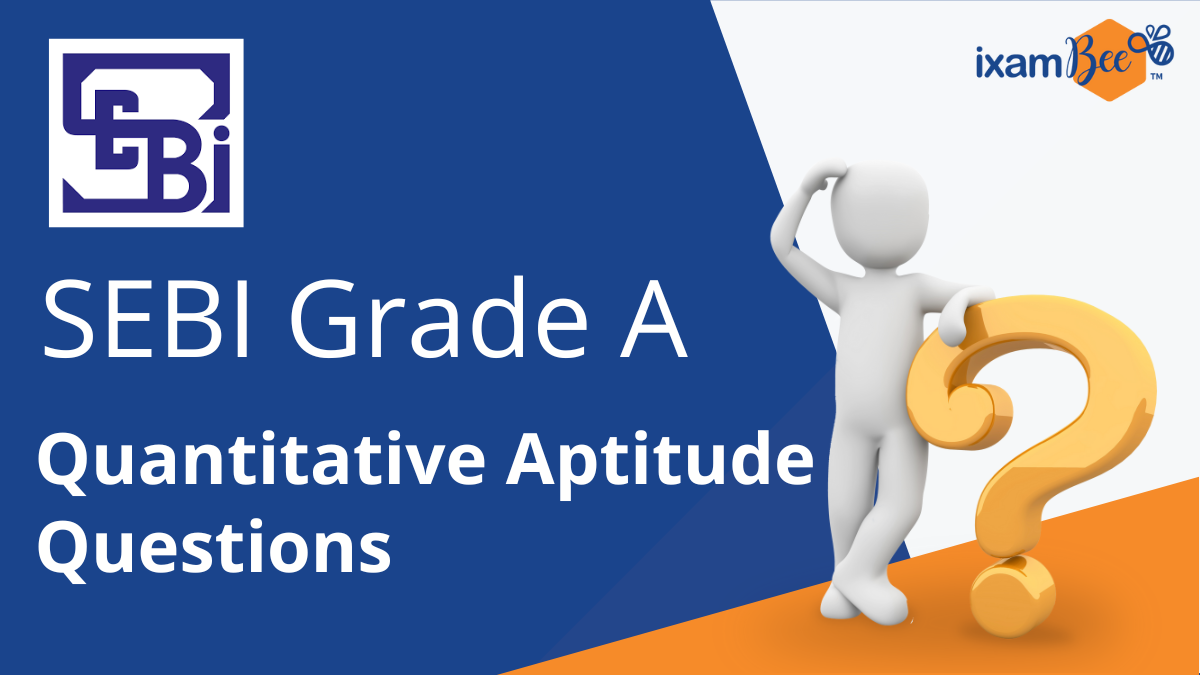Hello everyone! SEBI Grade A notification 2024 may be released soon. Keep watch for the upcoming notification, initiating your preparation early to enhance your chances of success. This is a golden opportunity for the candidates who wish to work with SEBI. Embrace this opportunity with enthusiasm, by gearing up for early preparation to pave the way for your achievements in this upcoming exam! Adequate preparation across all SEBI Grade A exam subjects is imperative for optimal performance. Therefore, if you want to do well in this exam, it is essential that aspiring candidates are prepared with all the subjects that are assessed in SEBI Grade A recruitment exam.
This article emphasizes the significance of the Quantitative Aptitude section in banking exams by spotlighting sample questions. Quantitative Aptitude holds paramount importance in banking assessments, testing candidates’ numerical skills and problem-solving abilities. By exploring these sample questions, candidates can comprehend the section’s nature, grasp various problem-solving methods, and prepare effectively for the challenging quantitative segment of SEBI Grade A exam.

SEBI Grade A : Exam Pattern
Phase 1 Exam Pattern
It is essential to have a thorough understanding of the SEBI Grade A exam syllabus and exam pattern in order to qualify for each stage of the recruitment process. Before going through the sample questions, it will be beneficial to understand the SEBI Grade A Phase 1 exam pattern.
In Phase 1 (Prelims), the candidates are tested based on the following four subjects-
- English Language
- General Awareness
- Reasoning Ability
- Quantitative Aptitude
Phase 2 Exam Pattern
The SEBI Grade A Phase 2 (Mains) exam will consist of two stages-
- English Paper (Descriptive)
- Professional Knowledge (Stream specific)
SEBI Grade A: Quantitative Aptitude
Quantitative Aptitude (QA) of the candidates is tested in Phase 1 of the SEBI Grade A recruitment process. Quantitative Aptitude is a scoring but tricky section since you have to solve many questions in a limited time. Therefore, it becomes all the more important to prepare this section well. Given below are some sample questions from the Quantitative Aptitude section to help you understand the level of questions that can be asked in the SEBI Grade A 2024 exam.
Quantitative Aptitude: Sample Questions
Q1) Ram sells only two kinds of bags—pure leather and faux leather, 75% and 80% of the total number of bags sold, in February and March respectively, were of pure leather. Average number of pure leather bags sold in both the months is 5850 and the total number of bags sold in March is 50% more than that sold in February. How many faux leather bags did Ram Sell in February?
- 2000
- 1600
- 1500
- 2500
- 1400
Answer: (3) 1500
Explanation:
Total no. of bags sold in Feb. = x
Total no. of bags sold in March = y
Given, y = x + 50/100 × x = 150/100 x
No. of pure leather bags sold in Feb. = 75/100 x And no. of pure leather bags in March 80/100 y
Given,
Avg. no. of pure leather bags = 5850
So total no. of pure leather bags = 5850 × 2 According to Question = 11700
75/100x + 80/100 y = 11700
=> 75/100 x + 80/100 × 150/100 x = 11700
=> x = 6000 bags
So, no. of pure leather bags sold in
Feb. = 75/100×6000 = 4500
No. of faux leather bags sold in Feb. = 6000 – 4500 = 1500
Q2) The respective ratio between the time taken by a bus to travel a certain distance at x kmph and the time taken by the bus to travel the same distance at (x + 20) kmph is 4 : 3. How much time will the bus take to travel 480 km at a speed of (x + 30) kmph?
- 4 hours 48 minutes
- 5 hours 10 minutes
- 4 hours
- 5 hours 20 minutes
- 6 hours
Answer: (4) 5 hours 20 minutes
Explanation:
Given, d = 4x
And d = 3(x + 20)
=> 4x = 3x + 60
=> x = 60 km
Now, t = 480 / (x + 30) = 480/90 = 5.33 hr = 5 hr 20 min.
Q3) A box contains 200 balls and each ball is marked with a number from 1 to 200. One ball was picked at random from the box, what is the probability that the ball picked has a number which is divisible by either 3 or 5?
- 91/200
- 51/200
- 81/200
- 93/200
- 53/100
Answer: (4) 93/100
Explanation:
Total no. divisible by 3 from 1 to 200 = 66
Total no. divisible by 5 from 1 to 200 = 40
And total no. divisible by both 3 and 5 from 1 to 200 = 13
Required probability = (66 + 40 – 13)/200 = 93/200
Q4) Some articles were bought at 6 for Rs. 5 and sold at 5 for Rs. 6. Gain percentage is?
- 30
- 33 ⅓
- 35
- 44
- 50
Answer: (4) 44
Explanation: Gain %
= [(m×) – (n×n)/(n×n)] × 100 =(6)2 –(5)2 /(5)2 ×100
= 36 – 25 /25 × 100 = 44%
Q5) Rani had a certain sum of money (Rs. x), out of which she pays Rs. 800 to the grocer. She paid 1/3 rd of Rs. x to her maid and gardener in the respective ratio of 2 : 1. If after all the mentioned expenses she is left with Rs. 2200, how much did she pay to her maid?
- 900
- 500
- 1000
- 400
- 200
Answer: (3) 1000
Explanation:
Rs. 800 = given to grocer
1/3x × 2/3 = 2/9x
Given to maid
1/3 x × 1/3 = 1/9x
Given to gardener
x – 100 – 2/9x – 1/9x = 2200 => 9x – 7200 – 3x = 19800
=> 6x = 27000
=> x = 4500
Amount she gave to maid = 2/9x = 2/9 × 4500 = Rs. 1000
Directions (Q6 to Q9) Study the following table and answer the given questions.
| Channels | No. of Viewers | Percentage by which number of subscribers is more than the number of non-subscribers |
| A | 400 | 50% |
| B | 550 | 300% |
| C | 480 | 200% |
| D | 360 | 800% |
Note: Number of viewers = Number of scribers + Number of non- subscribers.
Q6) The number of viewers of Channel E is five-ninth of that of Channel D. If the number of non-subscribers for Channel E is equal to that of Channel D, What is the number of subscribers for Channel E?
- 168
- 148
- 154
- 164
- 172
Answer: (4) 164
Explanation:
No. of viewers of channel E = 5/9 × 360 = 200 No. of non-subscribers for E
No. of non-subscribers for D
Let, x = no. of subscribers,
And y = no. of non-subscribers
=> x = y + 800/100 y (given)
=> x + y = 360 …(i)
=> x = 9y
From (i) y = 36
So, no. of non-subscribers for E = 36
No. of subscribers = 200 – 36 = 164
Q7) What is the average number of subscribers for Channels A, C and D?
- 312
- 298
- 294
- 308
- 310
Answer: (4) 308
Explanation:
For channel A :
No. of subscribers = x1
And no. of non-subscribers = y1
x1 + y1 = 400
x1 = y1 + 50/100 y1
= 150/100 y1
150/y1 + y1 = 400
=> y1 = 400×100/250 = 160
x1 = 400 – 160 = 240
For Channel C:
No. of subscribers = y2
y2 + y2 = 480
-> x2 = y2 + 200/100 y2
which equals to 3y2
= 4y2 = 480
=> y2 = 120
X2 = 480 – 120 = 360
For channel D:
No. of subscribers = x3
And no. of non-subscribers = y3
x3 + y3 = 360
-> x3 = y3 + 800 / 100 y3
= 9y3
=> 10y3 = 360
y3 = 36
x3 = 360 – 36 = 324
Avg. = x1 + x2 + x3 / 3
= 240 + 360 + 324 / 3
= 924 / 3 = 308
Q8) What percent of viewers of channel A have not subscribed for the channel?
- 40
- 20
- 25
- 60
- 50
Answer: (1) 40
Explanation:
Let subscribers of channel A = x
And non-subscribers of channel A = y
x + y = 400 …(i)
x = 50/100 y + y
= 150/100 y
From (i),
150/100 y + y 400
=> y = 160 (non-subscribers)
% = 160/400 × 100 = 40%
Q9) The number of subscribers for Channel B is what percent more than that for Channel C?
- 20 ⅓
- 22 2/9
- 23 1/9
- 24 2/9
- 21 1/9
Answer: (2) 22 2/9
Explanation:
For channel B:
Subscribers= x
non-subscribers= y
x + y = 550 …(i)
x = 300/100 y + y = 4y
4y + y = 550
=> y = 110 (non-subscribers)
x = 550 – 110
= 440 (subscribers)
For channel C:
subscribers= x1
non-subscribers= y1
x1 + y1 = 480 …(ii)
x1 = y1 + 200 y1 = 3y1
4y1 = 480
=> y1 = 120 (non-subscribers)
x1 = 480 – 120 = 360 (subscribers)
% increase = 440 – 360 / 360 × 100
=22 2/9%
Study with ixamBee for SEBI Grade A 2024
If you are still having any difficulty in solving such questions, ixamBee is here to assist you. You can take a look at ixamBee’s SEBI Grade A previous year papers for Phase1 (Prelims) to understand the question trend in detail. These are absolutely free.
We also encourage you to take the Free Online Mock Tests for SEBI Grade A as giving mock tests will assist you in identifying your weak areas and judge your preparation before the exam.
If the need arises, you can also seek expert guidance regarding SEBI Grade A 2024 preparation.
At ixamBee, you can find free Online Test Series, GK updates in the form of BeePedia, as well as latest updates for SBI PO, Bank Clerk, SSC, RBI, NABARD, and Other Government Jobs.
Also Read
How to Prepare for SEBI Grade A Exam 2024 in Less Time
Self Study: A Reality or Myth for SEBI Grade A 2024?
Easy Tips and Tricks to Clear SEBI Grade A Exam 2024















